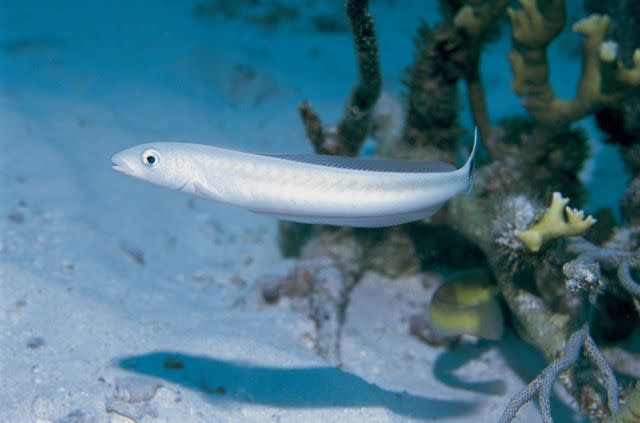How Does Mercury Get in Fish?
Human activity is primarily responsible for the increased levels of mercury in seafood—here's how it happens and what we can do.

Corey Ford/Stocktrek Images / Getty Images
Larger and longer-lived fish, like marlin, tend to contain the most mercuryNearly all seafood contains mercury, a naturally occurring metal buried deep in the Earth’s crust. At room temperature, elemental mercury is quite dangerous; just a few drops can contaminate an entire room. When heated, the element becomes an odorless, colorless gas that can travel great distances before being absorbed into bodies of water. It can also enter lakes, rivers, and oceans when human activities' waste or runoff flows into the surrounding biomes.
Here, we explore how this hazardous metal escapes from rocks to pollute aquatic habitats. We also detail measures we can take to remove mercury from marine ecosystems, improving the health of marine animals and the ocean.
Mercury and the Environment
Mercury finds its way out of the Earth and into living creatures in several ways. While forest fires and volcanoes release toxic gas into the atmosphere, the most significant cause is human activity, accounting for nearly two-thirds of all mercury released into the environment.
Each year in the United States, burned fossil fuels release 160 tons of mercury into the atmosphere. Eventually, it returns to Earth through rainfall, air deposition, or gravitational forces and is transferred into the ocean. Research estimates that between 80,000 and 450,000 metric tons of mercury pollute our oceans, with around 66% of the chemical residing in shallower waters.
Agricultural processes; municipal, industrial, and medical waste; and the burning of wood or any mercury-containing waste can also release the toxin into the air. This is known as non-point source pollution.
Mercury can also enter environments through direct point sources where factories—including paper mills and battery manufacturers—or mining operations expel the chemical into nearby marine habitats. Mercury can also contaminate freshwater when engineers flood land to create reservoirs for hydroelectric power. As the waterlogged plants and trees decay, the resulting low-oxygen environment allows bacteria to thrive, and those microorganisms combine elemental or inorganic mercury with carbon to create methylmercury.
Methylmercury is a neurotoxic compound of mercury and carbon that bioaccumulates in the marine food chain. When humans consume mercury, it is almost always in this form.
In this compounded form, methylmercury can attach itself to tiny particles in the water and soil in aquatic habitats, where it collects and builds up throughout the food web. According to the Centers for Disease Control, it is this hazardous substance in specific that scientists see collecting in living creatures—from coral, to fish, to birds, to humans.
Fish and Mercury Exposure

Tilefish contain high levels of mercury.
Because anthropogenic activity expels so much mercury into the atmosphere, nearly all aquatic life around the globe has traces of mercury as well as other contaminants known as persistent organic pollutants. One 2009 study from the U.S. Geological Service found mercury in every fish sampled from 291 streams across the country; a quarter of the fish tested had mercury levels that exceeded human consumption guidelines.
Mercury is also highly bioaccumulative, meaning that concentrations of the element increase simply because living creatures absorb it from their surrounding environment. Once released into a body of water, mercury attaches itself to the fat cells of fish, passing through the lipid membranes of cells and spreading throughout the surrounding tissue.
Because it binds so well with proteins and amino acids in the muscle of fish, mercury quickly travels up the food chain. Small fish eat particles containing mercury; then those fish are eaten by bigger fish where the mercury from the small fish coalesces, increasing by roughly a factor of 10 at each step along the way. The longer the fish lives, the more mercury it retains.
The Food and Drug Administration (FDA) lists top predator species—including tilefish, swordfish, sharks, and king mackerel—as the fish with the highest levels of mercury. In contrast, bottom-feeding scallops, clams, and shrimp have the lowest. Fish exposed to the methylated element can experience several issues, including reproductive toxicity, congenital disabilities, and disruptions to the nervous system.
While the effects of mercury consumption on humans have been widely studied, its impact on fish and aquatic ecosystems has not seen the same level of investigation. Still, the limited research describes how mercury can damage fish genes, cells, and proteins, causing profound changes to behavior, growth, and survival.
Learn More:This Acronym Will Help You Choose Ethical, Sustainable Seafood
Humans and Mercury Exposure
People exposed to mercury by eating contaminated fish, working in mercury mines, or other means suffer from similar health problems. Either through food consumption or air pollution, mercury is almost entirely absorbed into the bloodstream and then distributed quickly through all the tissues of the body. The largest amount of the poison collects in the brain, which is why mercury is considered a neurological toxin.
With an estimated half-life of 39 to 80 days, levels of the toxin can build up in the human body over time, just like in fish.
Reducing Mercury Exposure
For those with the preference and privilege to avoid eating fish, reducing mercury exposure from eating fish is simple enough. For the three billion people worldwide who depend on seafood for survival, it’s difficult to fathom that the advice to avoid mercury exposure is simply to eat fish in moderation. But short of global governmental intervention, eating less fish may be consumers’ only way of avoiding harmful levels of this ever-present toxin.
Only by reducing the amount of mercury introduced into the atmosphere can humans lower the amount of mercury in fish. Luckily, research at the International Institute for Sustainable Development Experimental Lakes Area found that when mercury is no longer added to an ecosystem, the ecosystem can heal, ultimately reducing the amount of mercury humans consume. This healing, however, can vary significantly between bodies of water; the response time in one part of the world might be quite different from somewhere else.
Still, positive changes are underway: 138 parties have ratified an international treaty called the Minamata Convention on Mercury. The initiative aims to #makemercuryhistory and to keep people healthy by reducing the number of neurotoxins released into the environment. Efforts include limiting mercury in consumer products (including skin-lightening face creams), banning the construction of additional mercury mines, and controlling the release of mercury in the air, water, and land.
Learn More:Minamata Convention Bans Mercury Satellite Propellants
The Environmental Protection Agency (EPA), too, has issued new standards controlling the emissions from power plants burning fossil fuels, and the efforts have made a significant difference in the health outcomes of people affected by mercury exposure. Since 2015 when the Mercury and Air Toxics Standards went into effect, the regulations have prevented 130,000 asthma attacks, 4,700 heart attacks, and 11,000 early deaths.
Incinerated municipal and medical waste was at one time a significant source of mercury emissions, but thanks to federal and state regulations, these emissions have been almost zeroed out. The EPA has also outlined the Methylmercury Fish Tissue Criterion—guidelines for acceptable levels of mercury in fish—as well as funding programs to clean up contaminated sites.
Restoring Ocean Health
Processes that remove mercury from aquatic habitats can play a role in rehabilitating global oceans. The most common, reliable, and affordable treatment is coagulation/filtration, which uses aluminum sulfate to consolidate both inorganic mercury and methylmercury into a solid that can be removed from the water and summarily disposed of at a hazardous waste site. Other processes include reverse osmosis, lime softening, and activated carbon.
Researchers have also looked to other aquatic life for inspiration to rid the ocean of mercury. Like all heavy metals, mercury is deadly to coral because the sea creatures so easily absorb the substance. In 2015 a team of scientists used this notion to invent a synthetic coral made of nanoplates of aluminum oxide that, through biomimicry, can actually remove mercury from the water by pulling in the metallic particles, just as biological coral would.
Mercury contamination is undeniably one of the biggest environmental issues humanity faces, and while there has been significant awareness of and progress toward removing mercury in seafood, without worldwide diligence, humans still face rising levels of exposure. Anthropogenic activities like industrial-scale agriculture and deforestation can potentially disturb the long-term storage of mercury in soils, creating another potential source of mercury pollution. Without further and fast action to restore ocean habitats to their historical level of mercury, the future of marine ecosystems—and, by extension, all life on Earth—could be in great peril.
Frequently Asked Questions
How harmful is mercury in fish?
Mercury in fish is harmful to the fish and the people who eat fish. It is a potent neurotoxin that can affect brain development in children and fetuses. That’s why the EPA recommends limiting the consumption of fish with higher concentrations and instead eating clams, shrimp, and scallops that have lower levels of exposure.
Do all fish have mercury in them?
According to the FDA, almost all shellfish and fish have at least trace levels of mercury.
What fish is lowest in mercury?
Small fish like anchovies, Atlantic mackerel, catfish, flounder, haddock, mullet, plaice, pollock, and salmon as well as shellfish like clams, crab, crawfish, and oysters have the lowest levels of mercury contamination, according to the FDA’s Dietary Guidelines for Americans.
Read Next: Which Household Items Contain Mercury?

